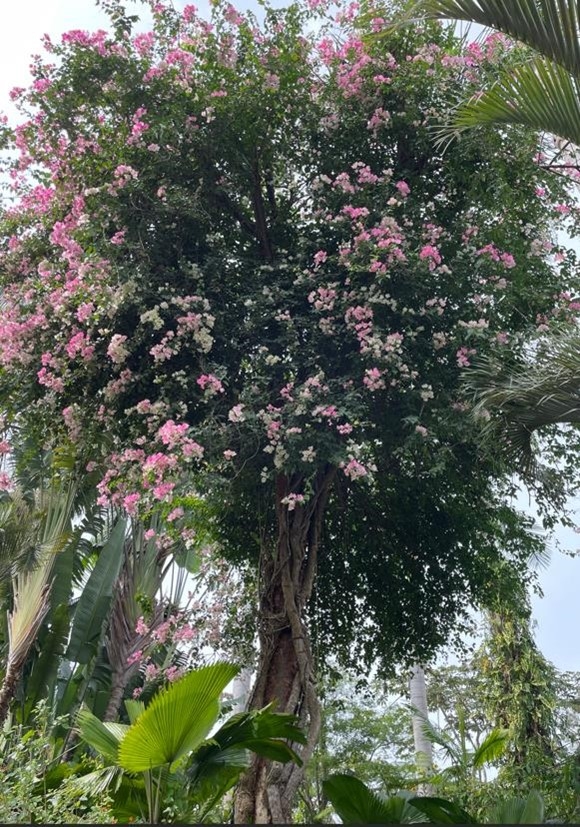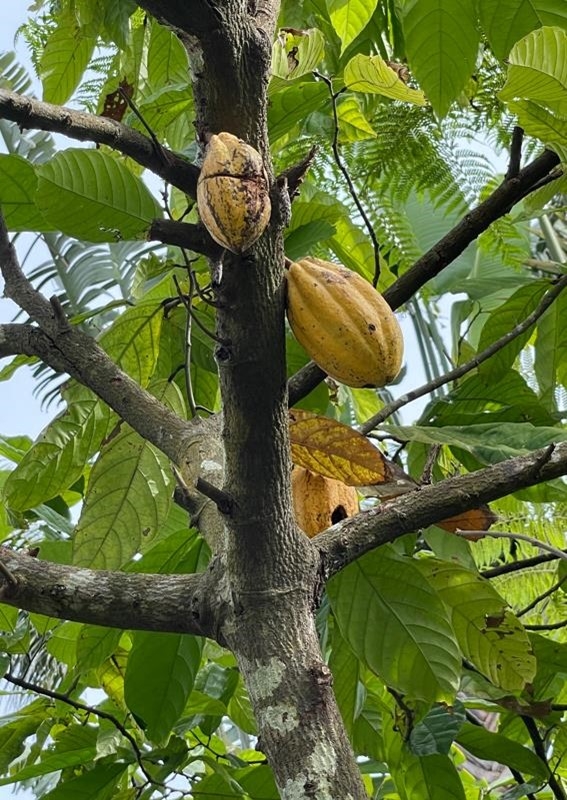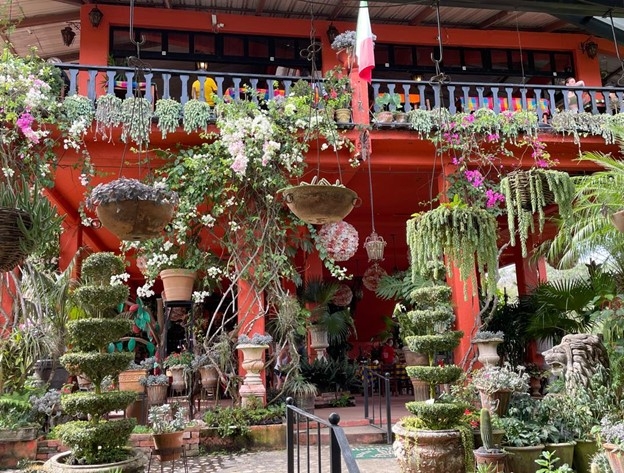In the gardener's view of the world, vacationers can be divided into two categories: those who sit around the pool and those who scurry around taking copious pictures of unfamiliar plants.
As a Master Gardener, I belong to the second category. So, when my husband and I flew to Puerto Vallarta to get away from the atmospheric river rains, there was one thing on my mind: tropical plants.
PuertoVallarta used to be a humble fishing village. It became a vacation destination sometime in the 1960s, after Sir Richard Burton (accompanied by Elizabeth Taylor) went there to film “The Night of the Iguana.”
The town is practically wedged into the Sierra Madre tropical jungle, which spills out into the city in the most enchanting ways. Step one street away from the main drag and you are likely to encounter a mind-boggling mix of tropical, Mediterranean, and desert flora: thickets of bougainvillea, cocoa and cinnamon trees, mountain coffee, heavily scented lemons and oranges, Mexican blue palms, tamarind, banyan, fig, and rubber trees, to name a few that will make your head spin.
Seeds from these plants are lying everywhere, tempting visiting plantaholics to take them home. Don't even think about it. To protect the state's agriculture, California has strict laws about bringing in living plant material. Fortunately, I got that urge out of my system long ago, after a handful of seeds I brought back from Palm Springs grew into a sizable fan palm grove that altered our backyard in unexpected ways. As my husband dryly noted, defying an old gardening adage, “No, there isn't always room for another plant.”
Sometimes it's better to leave plants where they are and enjoy them in their natural habitat, which brings me to the highlight of our trip: Vallarta Botanical Garden.
The garden was founded in 2004. For many years, it has been a leader in nature conservancy, discovering, studying, and preserving native Mexican plants. It has a “sister garden” relationship with San Francisco and Santa Barbara Botanical Gardens. American Public Garden Association ranked it third on a list of the “Top 10 Best Botanical Gardens.” I suspect that they did not take into consideration the garden's delightful restaurant overlooking Río Horcones and serving great margaritas. Otherwise, it would have been number one.
The garden covers 79 acres, so it is impossible to see it all in one day. Most visitors spend their time in the manicured main area and do not venture into the tropical forest outside which has a vast living collection of oaks and Mexican magnolias. The Aztecs revered magnolias for their beautiful scent and shape as well as their medicinal properties.
Inside the main area are three notable attractions: orchids, a pollinator garden and a collection of succulents and cacti. The latter are part of a whimsical display featuring Mexican pottery, statues of various beasts and many ingenious plant stands.
The pollinator garden is really an alley with lush, blooming plants on both sides and the constant buzz of insects flying from one border to another. Walking through it, you almost feel like an outsider eavesdropping on nature's most intimate activity.
Although bees typically get the most credit for pollination, Mexico has a tremendous variety of beetles and flies that often perform specialized tasks due to their size, such as pollinating tiny cocoa flowers. The butterfly family (with everybody's favorite, the monarchs) is the fourth largest pollinator group.
The most important project in the garden is conservation and propagation of Mexican orchids. In contrast to Napa Valley, where virtually all the orchids for sale in stores are the same species, Mexico is home to 1,300 orchid species. Some are unique to Mexico and found nowhere else. Unfortunately, even though they grow mostly at high elevations, they are still endangered due to deforestation, poaching and climate calamities.
Replicating the orchid's natural reproduction process in a lab is a complicated affair. Consider the rare Mexican orchid, Vanilla pompona, one of the most valuable spices in the world. Its pod contains over 3,000 seeds. To successfully propagate, a single seed needs specific light, temperature, humidity, and nutrient conditions, including the presence of certain fungi that will nourish the baby orchid for its first three years.
Learning about new cultures, plants and ecosystems is always inspiring, but by the end of our trip, I was ready to head home to Napa and my own garden. Luckily, my husband was happy to oblige. We said goodbye to Puerto Vallarta but vowed to return: him to the pool, and me, back to the jungle.
To learn more about pollinating plants, visit Las Flores Learning Garden in Napa, home to more than 60 pollinator-attracting plants. In April, it will be buzzing with insects.
Tomato Plant Sale: UC Master Gardeners of Napa County holds its annual tomato plant sale on Saturday, April 13, from 9 am until sold out, at 1710 Soscol Avenue, Napa. Choose from 25 varieties grown by Napa County Master Gardeners. Plants are $5 each, cash or check only.
Workshop: Join UC Master Gardeners of Napa County for “Growing Tomatoes” on Sunday, April 14, from 2 pm to 3 pm, via Zoom. We'll discuss types of tomato plants and how to care for them, including soil and watering needs, staking, pest prevention and more. Register to receive the Zoom link.
Workshop: Join UC Master Gardeners of Napa County for “Irrigation for Low-Water Gardens” on Saturday, April 27, from 10 am to noon, at Las Flores Learning Garden, 4300 Linda Vista Avenue, Napa. Get instruction on how to create an efficient system for your garden. Presenters will also show how the drip system at the Las Flores Learning Garden was created. Register here. Help Desk:
The Master Gardener Help Desk is available to answer your garden questions on Mondays and Fridays from 10 am until 1 pm at the University of California Cooperative Extension Office, 1710 Soscol Avenue, Suite 4, Napa. Or send your questions to mastergardeners@countyofnapa.org. Include your name, address, phone number and a brief description.


